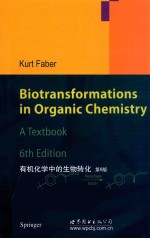

有机化学中的生物转化 第6版 英文PDF电子书下载
- 电子书积分:14 积分如何计算积分?
- 作 者:(奥)费伯(Faberk)著
- 出 版 社:上海:世界图书上海出版公司
- 出版年份:2014
- ISBN:9787510078729
- 页数:424 页
1 Introduction and Background Information 1
1.1 Introduction 1
1.2 Common Prejudices Against Enzymes 2
1.3 Advantages and Disadvantages of Biocatalysts 3
1.3.1 Advantages of Biocatalysts 3
1.3.2 Disadvantages of Biocatalysts 7
1.3.3 Isolated Enzymes vs.Whole Cell Systems 9
1.4 Enzyme Properties and Nomenclature 11
1.4.1 Structural Biology in a Nutshell 11
1.4.2 Mechanistic Aspects of Enzyme Catalysis 13
1.4.3 Classification and Nomenclature 23
1.4.4 Coenzymes 26
1.4.5 Enzyme Sources 27
References 27
2 Biocatalytic Applications 31
2.1 Hydrolytic Reactions 31
2.1.1 Mechanistic and Kinetic Aspects 31
2.1.2 Hydrolysis of the Amide Bond 51
2.1.3 Ester Hydrolysis 60
2.1.4 Hydrolysis and Formation of Phosphate Esters 111
2.1.5 Hydrolysis of Epoxides 120
2.1.6 Hydrolysis of Nitriles 130
2.2 Reduction Reactions 139
2.2.1 Recycling of Cofactors 140
2.2.2 Reduction of Aldehydes and Ketones Using Isolated Enzymes 145
2.2.3 Reduction of Aldehydes and Ketones Using Whole Cells 153
2.2.4 Reduction of C=C-Bonds 166
2.3 Oxidation Reactions 173
2.3.1 Oxidation of Alcohols and Aldehydes 173
2.3.2 Oxygenation Reactions 176
2.3.3 Peroxidation Reactions 204
2.4 Formation of Carbon-Carbon Bonds 211
2.4.1 Aldol Reactions 211
2.4.2 Thiamine-Dependent Acyloin and Benzoin Reactions 225
2.4.3 Michael-Type Additions 231
2.5 Addition and Elimination Reactions 233
2.5.1 Cyanohydrin Formation 233
2.5.2 Addition of Water 237
2.5.3 Addition of Ammonia 240
2.6 Transfer Reactions 242
2.6.1 Glycosyl Transfer Reactions 242
2.6.2 Amino Transfer Reactions 254
2.7 Halogenation and Dehalogenation Reactions 257
2.7.1 Hálogenation 258
2.7.2 Dehalogenation 263
References 268
3 Special Techniques 315
3.1 Enzymes in Organic Solvents 315
3.1.1 Ester Synthesis 324
3.1.2 Lactone Synthesis 342
3.1.3 Amide Synthesis 343
3.1.4 Peptide Synthesis 346
3.1.5 Peracid Synthesis 351
3.1.6 Redox Reactions 352
3.1.7 Medium Engineering 354
3.2 Immobilization 356
3.3 Artificial and Modified Enzymes 367
3.3.1 Artificial Enzyme Mimics 367
3.3.2 Modified Enzymes 368
3.3.3 Catalytic Antibodies 373
References 377
4 State of the Art and Outlook 391
References 396
5 Appendix 397
5.1 Basic Rules for Handling Biocatalysts 397
5.2 Abbreviations 400
5.3 Suppliers of Enzymes 401
5.4 Commonly Used Enzyme Preparations 402
5.5 Major Culture Collections 404
5.6 Pathogenic Bacteria and Fungi 405
Index 407
- 《生物质甘油共气化制氢基础研究》赵丽霞 2019
- 《分析化学》陈怀侠主编 2019
- 《化学反应工程》许志美主编 2019
- 《危险化学品经营单位主要负责人和安全生产管理人员安全培训教材》李隆庭,徐一星主编 2012
- 《奶制品化学及生物化学》(爱尔兰)福克斯(FoxP.F.)等 2019
- 《有机化学实验》雷文 2015
- 《全国普通高等中医药院校药学类专业十三五规划教材 第二轮规划教材 分析化学实验 第2版》池玉梅 2018
- 《生物化学》田余祥主编 2020
- 《长江口物理、化学与生态环境调查图集》于非 2019
- 《化学工程与工艺专业实验指导》郭跃萍主编 2019
- 《中风偏瘫 脑萎缩 痴呆 最新治疗原则与方法》孙作东著 2004
- 《水面舰艇编队作战运筹分析》谭安胜著 2009
- 《王蒙文集 新版 35 评点《红楼梦》 上》王蒙著 2020
- 《TED说话的力量 世界优秀演讲者的口才秘诀》(坦桑)阿卡什·P.卡里亚著 2019
- 《燕堂夜话》蒋忠和著 2019
- 《经久》静水边著 2019
- 《魔法销售台词》(美)埃尔默·惠勒著 2019
- 《微表情密码》(波)卡西亚·韦佐夫斯基,(波)帕特里克·韦佐夫斯基著 2019
- 《看书琐记与作文秘诀》鲁迅著 2019
- 《酒国》莫言著 2019
- 《TED说话的力量 世界优秀演讲者的口才秘诀》(坦桑)阿卡什·P.卡里亚著 2019
- 《小手画出大世界 恐龙世界》登亚编绘 2008
- 《近代世界史文献丛编 19》王强主编 2017
- 《课堂上听不到的历史传奇 世界政治军事名人 初中版》顾跃忠等编著 2015
- 《365奇趣英语乐园 世界民间故事》爱思得图书国际企业 2018
- 《近代世界史文献丛编 36》王强主编 2017
- 《近代世界史文献丛编 11》王强主编 2017
- 《近代世界史文献丛编 18》王强主编 2017
- 《乐队伴奏长笛世界名曲集 4》芭芭拉·哈斯勒-哈瑟 2017
- 《世界名著阅读经典 欧也妮·葛朗台 高老头 全译本 12-16岁》(法)巴尔扎克著 2017
